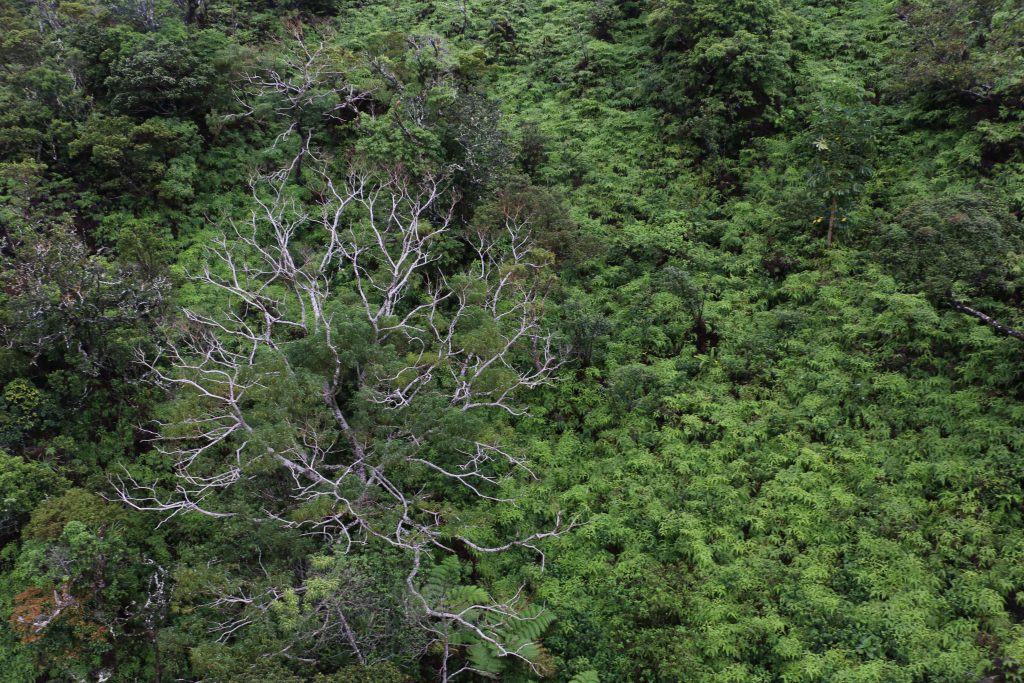07/31/19-RAPID ʻŌHIʻA DEATH NOW DETECTED ON FOUR ISLANDS
Posted on Jul 31, 2019 in Forestry & Wildlife, Invasive Species, sliderNews Release
| DAVID Y. IGE GOVERNOR |
SUZANNE D. CASE
CHAIRPERSON |
For Immediate News Release: July 31, 2019
RAPID ʻŌHIʻA DEATH NOW DETECTED ON FOUR ISLANDS
Less Aggressive Strain Discovered on O‘ahu
To view video please click on photo or view at this link:
(Honolulu) – One of the species of fungus causing Rapid ʻŌhiʻa Death (ROD) was recently detected for the first time on O`ahu. A team of natural resource managers from the O`ahu Invasive Species Committee (OISC) and the Ko’olau Mountain Watershed Partnership (KMWP) recently sampled a dead ʻōhiʻa tree on private land in a remote area in the Ko’olau Mountains above Pearl City.
The sample was analyzed by the USDA Agriculture Research Service lab in Hilo. It confirmed the presence of Ceratocystis huliohia. Although this is the less aggressive of the two Ceratocystis species associated with ROD, it still has the ability to kill ʻōhiʻa trees.
A partnership of state, federal, university, and non-government organizations have been conducting systematic helicopter and ground surveys to look for Rapid ʻŌhiʻa Death since 2016. On Oʻahu, 150 dead or unhealthy ʻōhiʻa trees have been sampled for the disease in the past three years, and all have been negative until now. The location of the infected tree is extremely remote and it is considered highly unlikely to have been spread by people. Researchers are still trying to understand the source of the two Ceratocystis pathogens and are looking at any possible patterns of dispersal.
This first detection on O‘ahu has initiated a rapid response which includes additional surveys to determine how widespread the disease is. A combination of helicopter, UAS (drone) and ground surveys are planned with OISC, DLNR and KMWP playing lead roles. The landowner, Kamehameha Schools, is working closely with the response agencies to coordinate access to the property so agencies are able to test for the fungus and prevent it from spreading.
Rapid ʻŌhiʻa Death threatens Hawaii’s most important tree species. ʻŌhiʻa grows throughout the Ko’olau and Waianae mountain ranges across approximately 50,000 acres. ʻŌhiʻa serves as a keystone species providing important watershed cover for recharging the island’s aquifer, habitat for endangered species, and cultural uses such as hula performances.
Residents and visitors can help protect our remaining ʻōhiʻa forests with the following actions:
- Avoid injuring ʻōhiʻa. Open wounds on ʻōhiʻa are an entry point for disease spores. The disease can also spread from tree to tree on machetes or other tools.
- Don’t transport ʻōhiʻa inter-island.
- Don’t move ʻōhiʻa wood or vegetation, especially from areas known to have ROD.
- Clean your hiking boots/gear/tools. Scrub off all dirt and spray boot soles and tools with 70% rubbing alcohol, and wash your clothes in hot water and use a dryer to ensure the disease is not spread on boots and clothing.
- Wash your vehicle if driving near ʻōhiʻa forests. The disease can remain alive and infectious in soil, so wash all dirt off vehicles.
Rapid ʻŌhiʻa Death has now been detected on Hawai‘i Island, Maui, Kaua‘i and O‘ahu since the fungal disease was first discovered in 2014. To date, the more aggressive form of the disease has not been found on Maui or O‘ahu, and is extremely limited on Kaua‘i.
###
To report dead or dying ʻōhiʻa on Oʻahu please call or text the Oahu Invasive Species Committee at (808) 286-4616 or e-mail [email protected].
Additional information about Rapid ʻŌhiʻa Death can be found at www.rapidohiadeath.org.
Media Contact:
Dan Dennison
Senior Communications Manager
(808) 587-0396
[email protected]
